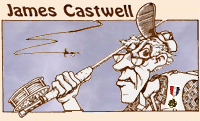|
Yup, two. You can sling the line (rod) or you
can snap it. Envision a stick about six feet
long with thirty feet of clothes-line tied to the
tip. You swing the stick hard enough and the line
will follow wherever the end of the stick goes.
Make circles, big or small, and the line will do
the same thing. Swing it from behind you to in
front and the line will go where you have it
pointed. I suppose this is a form of casting, I
see it done most of the time when guys are trying
to cast over sixty feet. Mostly you are waving the
rod. There is no stop intended. A bit like a
gymnastic event with ribbons that young girls
perform.
The other way is like a fly-swatter. Not many of
us try to smash a fly with it, we stop the swatter
just short of the wall and the top part snaps
forward and does the deed. The harder you stop
the bigger the spot on the wall, so to speak.
These two principles are often mixed into one cast.
But, not at first. A beginner will often start out
with the sling method, and just as often attain
some small degree of success for a time. Certainly
long enough to get on the water and get his feet
wet in our sport. And this is alright, if the line
goes out in front, that for a time is success. One
simply needs to get rather close to his quarry.
If you are so inclined, try this sometime. Lay out
sixty feet or so of fly line behind you on a lawn.
Get it nice and straight, walk down to the fly end
and pull on it until it is nearly perfect. Go back
and carefully pick up your rod but keep the rod
pointed back at the fly, no slack, none at all.
Now, with your back to the fly, carefully raise
the rod, keeping the line nice and tight, and make
a hard forward cast. There, you have now cast sixty
feet or thereabouts.
What was needed here was a great back-cast with no
slack. We did that by hand, but so what. How else
are you going to learn the value of a great back-cast
when you start out. Remember, when you first start out,
if the line ends up in front of you somewhere, you
did at least something right. You didn't do anything
wrong, you just didn't do enough things right to make
the cast even better. To be sure, if the cast landed
behind you, indeed, you really did something wrong.
This is the sling method.
Now if you had come to a hard stop at about sixty
degrees with the rod, the line may have gone even
farther. In fact, that would be the snap (fly-swatter)
method. Now before I get accused of coming up with
yet another name for stopping the casting stroke,
I am not. I used that word to differentiate it
from the sling.
To snap a cast, you do just that. But it only works
if the 'stick' (rod?) is flexible. The end of the
stick must be able to flip (snap) forward when it
comes to a hard stop (fly-swatter). The additional
movement helps propel the line even faster and farther.
And the harder you stop the rod the farther the line
goes.
Eventually you can help the whole thing along by
getting the line up to higher speed with your off-hand
(double-haul) and either sling or snap the cast.
Slinging and the 'DH' can produce very long casts,
but, not as long as the snap and the DH. First things
first. Make sure you can do both the snap and the sling
and know the difference between them. Then advance
at whatever speed you need for where you fish. ~ James Castwell
|



